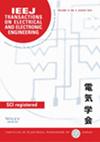求助PDF
{"title":"利用壁后波导在共振微波加热辅助下进行银纳米粒子的片上连续合成","authors":"Kaito Fujitani, Mitsuyoshi Kishihara, Munehiro Sugiyama, Yuichi Utsumi","doi":"10.1002/tee.24169","DOIUrl":null,"url":null,"abstract":"<p>Microfluidics made of dimethylpolysiloxane were developed for chemical synthesis using microwave heating at 24.125 GHz, and microwave efficiency was enhanced by the microwave resonance effect. In addition, the device was fabricated using a mold created using a 3D printer to reduce production costs. The microchip structure comprised a post-wall waveguide and a microchannel that passed through the waveguide. This post-wall waveguide also comprises metal columns (post-wall) instead of a conductor side wall, and easily introduces microchannels through the gaps between the metal columns. The waveguide length was adjusted to achieve a resonance frequency of 24 GHz using an electromagnetic wave simulation, assuming that the microchannel was filled with pure water. Microwaves with an input power of 4 W caused a maximum temperature increase of 93 °C; this result is ~10 °C higher than that of a microchip with non-resonant structure. In this study, Ag nanoparticles were synthesized using a chemical reaction induced by microwave irradiation of a chip flow system. Owing to irradiating the mixing reagent with microwaves of an input power of 4 W while controlling the flow rate at 0.7 μl/min, the formation of Ag nanoparticles with an average particle size of ~19.2 ± 2.4 nm was demonstrated by absorbance measurements and dynamic light scattering. It is expected that microwave microfluidics enhanced by the resonance effect will substantialize nanoparticle synthesis and high-efficiency automated chemical synthesis combined with multichemical unit operations. © 2024 Institute of Electrical Engineers of Japan and Wiley Periodicals LLC.</p>","PeriodicalId":13435,"journal":{"name":"IEEJ Transactions on Electrical and Electronic Engineering","volume":"19 12","pages":"2072-2080"},"PeriodicalIF":1.0000,"publicationDate":"2024-07-18","publicationTypes":"Journal Article","fieldsOfStudy":null,"isOpenAccess":false,"openAccessPdf":"","citationCount":"0","resultStr":"{\"title\":\"Continuous On-Chip Synthesis of Ag Nanoparticles Assisted by Resonant Microwave Heating Using a Post-Wall Waveguide\",\"authors\":\"Kaito Fujitani, Mitsuyoshi Kishihara, Munehiro Sugiyama, Yuichi Utsumi\",\"doi\":\"10.1002/tee.24169\",\"DOIUrl\":null,\"url\":null,\"abstract\":\"<p>Microfluidics made of dimethylpolysiloxane were developed for chemical synthesis using microwave heating at 24.125 GHz, and microwave efficiency was enhanced by the microwave resonance effect. In addition, the device was fabricated using a mold created using a 3D printer to reduce production costs. The microchip structure comprised a post-wall waveguide and a microchannel that passed through the waveguide. This post-wall waveguide also comprises metal columns (post-wall) instead of a conductor side wall, and easily introduces microchannels through the gaps between the metal columns. The waveguide length was adjusted to achieve a resonance frequency of 24 GHz using an electromagnetic wave simulation, assuming that the microchannel was filled with pure water. Microwaves with an input power of 4 W caused a maximum temperature increase of 93 °C; this result is ~10 °C higher than that of a microchip with non-resonant structure. In this study, Ag nanoparticles were synthesized using a chemical reaction induced by microwave irradiation of a chip flow system. Owing to irradiating the mixing reagent with microwaves of an input power of 4 W while controlling the flow rate at 0.7 μl/min, the formation of Ag nanoparticles with an average particle size of ~19.2 ± 2.4 nm was demonstrated by absorbance measurements and dynamic light scattering. It is expected that microwave microfluidics enhanced by the resonance effect will substantialize nanoparticle synthesis and high-efficiency automated chemical synthesis combined with multichemical unit operations. © 2024 Institute of Electrical Engineers of Japan and Wiley Periodicals LLC.</p>\",\"PeriodicalId\":13435,\"journal\":{\"name\":\"IEEJ Transactions on Electrical and Electronic Engineering\",\"volume\":\"19 12\",\"pages\":\"2072-2080\"},\"PeriodicalIF\":1.0000,\"publicationDate\":\"2024-07-18\",\"publicationTypes\":\"Journal Article\",\"fieldsOfStudy\":null,\"isOpenAccess\":false,\"openAccessPdf\":\"\",\"citationCount\":\"0\",\"resultStr\":null,\"platform\":\"Semanticscholar\",\"paperid\":null,\"PeriodicalName\":\"IEEJ Transactions on Electrical and Electronic Engineering\",\"FirstCategoryId\":\"5\",\"ListUrlMain\":\"https://onlinelibrary.wiley.com/doi/10.1002/tee.24169\",\"RegionNum\":4,\"RegionCategory\":\"工程技术\",\"ArticlePicture\":[],\"TitleCN\":null,\"AbstractTextCN\":null,\"PMCID\":null,\"EPubDate\":\"\",\"PubModel\":\"\",\"JCR\":\"Q4\",\"JCRName\":\"ENGINEERING, ELECTRICAL & ELECTRONIC\",\"Score\":null,\"Total\":0}","platform":"Semanticscholar","paperid":null,"PeriodicalName":"IEEJ Transactions on Electrical and Electronic Engineering","FirstCategoryId":"5","ListUrlMain":"https://onlinelibrary.wiley.com/doi/10.1002/tee.24169","RegionNum":4,"RegionCategory":"工程技术","ArticlePicture":[],"TitleCN":null,"AbstractTextCN":null,"PMCID":null,"EPubDate":"","PubModel":"","JCR":"Q4","JCRName":"ENGINEERING, ELECTRICAL & ELECTRONIC","Score":null,"Total":0}
引用次数: 0
引用
批量引用

 求助内容:
求助内容: 应助结果提醒方式:
应助结果提醒方式:


